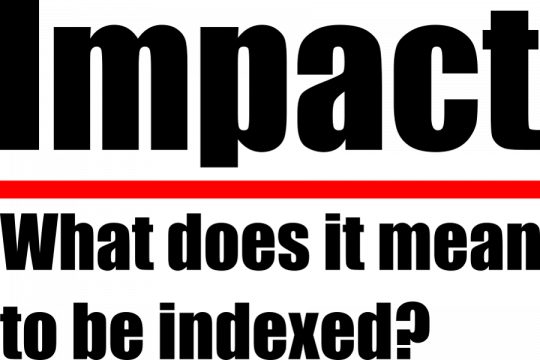Being indexed

There are many databases storing and analysing scientific publications. "Being indexed" or "being listed" simply means for a journal that one of these databases includes the articles that are published in this journal. Importantly, several of these databases also include citation data for each article; therefore they are often referred to as journal citation databases. Since there are many such databases, virtually every journal is "listed" somewhere and if you want to get your journal listed, there are several guides out there, e.g. Getting your journal indexed. However, in the life sciences, there are a few databases that are substantially more important and authoritative than others. The big three are MEDLINE, Web of Science and Scopus. How are these three databases different? Clearly, the most important journals are covered by all of them. But less important journals and journals that publish in non-English languages might be only listed by one or two of the three. The databases have different journal selection criteria (see below) and the selection is subject to constant change.
MEDLINE
MEDLINE is a non-commercial database that is maintained by the US-American National Library of Medicine and the selection of journals happens under NIH-oversight. MEDLINE and especially its online portal PubMed are exceptional due to their free accessibility for everybody. In fact, PubMed is probably the only transparent academic bibliographic database that can be used for free by everybody to research life science literature. MEDLINE currently indexes 5620 journals.
Web of Science
The Web of Science comprises several databases and they used to be maintained by the Institute of Scientific Information (ISI), before it was sold to Thomson Scientific & Healthcare (nowadays Thomson Reuters). The ISI was founded by Eugene Garfield, who is considered to be the father of bibliometrics and scientometrics. The Web of Science currently indexes 13762 journals (combined Arts & Humanities, Expanded Science and Social Sciences Citation Indexes).
Scopus
The other commercial journal database is Scopus, which is owned by Elsevier, the largest publisher of scientific journals. Scopus is the largest of these three databases covering many more journals than the other two. According to some, this is due to the somewhat loosely applied journal selection criteria (http://www.issi2015.org/files/downloads/all-papers/1198.pdf). There has also been some discussion about the independence of the journal selection for commercial databases. After all, according to a study published in PlosOne, five companies control more than half of all academic publishing, with Elsevier dominating at about 25% of the market (http://dx.doi.org/10.1371/journal.pone.0127502). Scopus indexes currently over 22000 journals.
People have been comparing databases and citation counts (e.g. here). One database, that I have been omitting is Google Scholar. Even though the free accessibility of Google Scholar and its broader approach to measure impact have advantages as opposed to Web of Science or Scopus, Google Scholar is - similar to the general Google search engine - not very open about what journals and sources its search covers. In my opinion, this is a big draw-back, but on the other hand Google probably constantly has to tweak its algorithm to avoid exploitation. If you want to know more about Google Scholar as a citation database, I recommend this article.
Journal Lists
MEDLINE: ftp://ftp.nlm.nih.gov/online/journals/lsi2015.xml,
http://www.ncbi.nlm.nih.gov/nlmcatalog?cmd=historysearch&querykey=1 (currently indexed)
http://www.ncbi.nlm.nih.gov/nlmcatalog/?term=reportedmedline (all)
Web of Science/Thomson Reuters: http://ip-science.thomsonreuters.com/mjl/
Scopus: https://www.elsevier.com/__data/assets/excel_doc/0015/91122/title_list.xlsx
Journal selection criteria
MEDLINE: https://www.nlm.nih.gov/pubs/factsheets/jsel.html
Web of Science/Thomson Reuters: http://wokinfo.com/essays/journal-selection-process/
Scopus: https://www.elsevier.com/__data/assets/pdf_file/0006/95118/SC_FAQ-conten...



